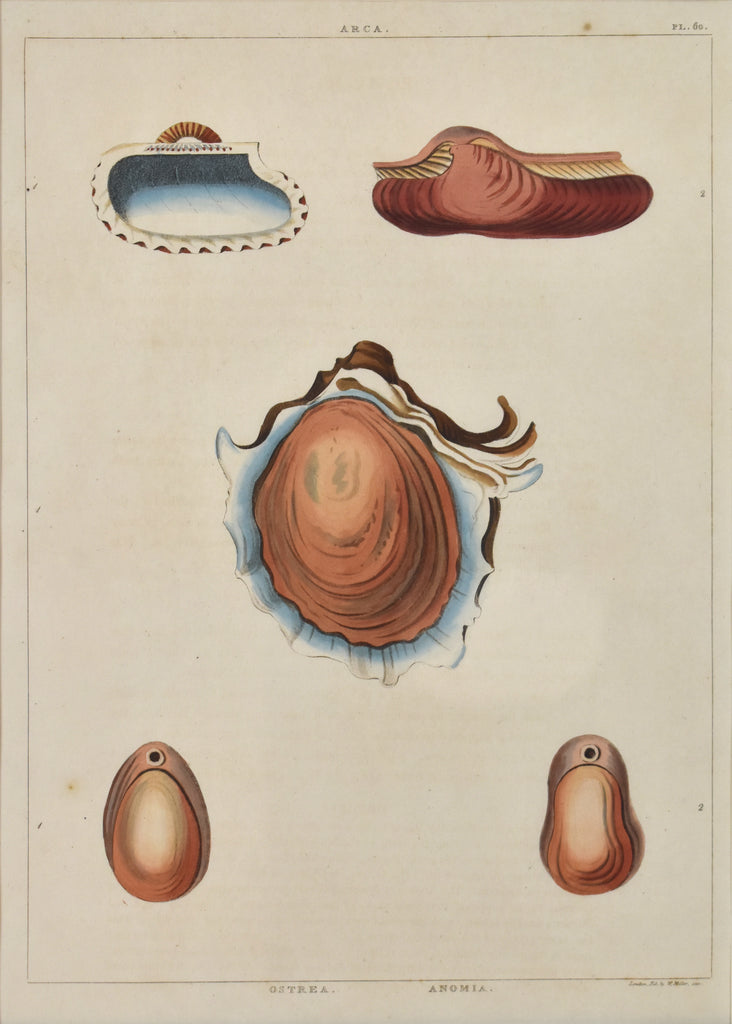-
Title: Arca, Ostrea, Anomia, PL. 60
-
Author: George Perry
-
Date: 1811
-
Medium: Hand-colored aquatint
-
Condition: Very Good +
-
Inches: 9 3/4 x 13 1/2 [Image]
-
Centimeters: 24.77 x 34.29 [Image]
-
Product ID: 3010038
George Perry, British naturalist and expert in malacology (the study of mollusks), published two major natural history works during his lifetime. One of them Arcana; or the museum of natural history, a richly-illustrated natural history magazine, was released in monthly installments from January 1810 to September 1811. He published his other major work, Conchology, or the natural history of shells, in 1811. The majority of Perry’s contemporaries ascribed to Linnaean taxonomy, the system of natural classification devised by Swedish botanist Carl Linnaeus in the eighteenth century. However, Perry adhered to the taxonomic system and theories of evolution popularized by French naturalist Jean-Baptiste Lamarck. As a result of these dissenting views, Perry’s work was deliberately ignored at the time by many of his fellow British naturalists. Very little is known about him today.
Includes the following page of corresponding descriptive text:
BIVALVES. PLATE LX.
Genus. ARCA.
Character. Shell, valves of an equal size, having a square elbow at one end, and round at the other; hinge having numerous teeth sharpened, and placed alternately.
Species.
No. 1. Arca Elegans. Shell of a pale red, white and blue within, the outer edge undulated. A native of Sierra Leone and the Gold Coast. From a shell in the Author's Museum.
No. 2. Arca Rubra. Shell of a strong red colour, streaked with red veins, the inside of a pale grey; the two shells being delineated together, convey to the mind an idea of Noah's Ark, being formed like a ship in the lower part, and covered over at the top, from which circumstance it is supposed this shell received its name.
Genus. OSTREA
Character. Shell, externally hollowed out, imbricated, and rugged; the valves unequal in size, hollowed out in the manner of an ear. The hinge having teeth slightly marked.
No. 1. Ostrea Dentata. Shell brown, lined with white and blue shades; the upper shell small, and of a flesh colour; this shell differs in form, in many respects, from the common oyster, particularly in its branched sides. It is a native of the East Indies.
Genus. ANOMIA.
Character. Shell, the valves unequal in size, one more rounded in the base than the other; sometimes one of the valves has a round hole near the hinge; hinge having only a lineal channel or ridge, but which is confined to that part.
Species.
No. 1. Anomia Ovata. Shell of a pale brown, oval, having a circular opening near the hinge; by passing a muscular membrane through this hole, the animal is supposed to attach itself to the rocks at the bottom of the sea.
No. 2. Anomia Undulata. Shell of a sinuated form, and gibbous below. A native (as well as the foregoing) of the Seas of the East Indies.
REMARKS
The genus Arca is well worthy the accurate examination of the skilful Conchologist, from its very singular construction, the teeth of the hinge slanting different ways; it seems to have a distant analogy to the genus Pecten, from which, however, its oblong and smoother form will always distinguish it. The Ostrea, or Oyster, is too well known to need any particular explanation. The Anomia is deserving of very particular attention, on account of Linnaeus having supposed that fossil shells of this genus were to found in shape and character exactly agreeing with the recent ones, to which he has given the same name. This has, however, one of the accidental errors of that great Naturalist, for, although they may agree in the generic character, yet in their exact specific shape, a constant difference occurs. In the examination of forty-five different fossil Anomiae found in Derbyshire and other parts of England, I did not find one of them to agree perfectly in shape with any living species.


